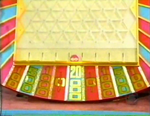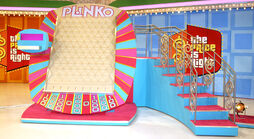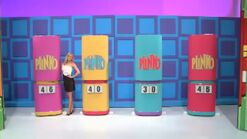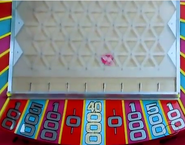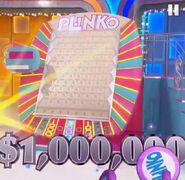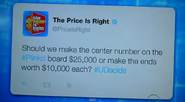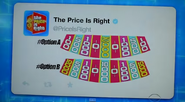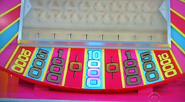Plinko is the most popular pricing game on The Price is Right. Debuting on January 3, 1983, it is played for a cash prize of up to $50,000 and also awards prizes valued under $100. It is frequently said to be the most Famous of all the pricing games.
Plinko was created by the late Executive Producer Frank Wayne. On the game's first playing, host Bob Barker explained that the name came from the "plink" sound the chips made as they came down the board.
Gameplay
The contestant is given one round flat disc, called a Plinko chip, and can earn up to four more using small prizes, for a total of five chips. The small prizes are presented one at a time, each bearing a two-digit price with one of the digits incorrect. The contestant must decide which digit is correct to win another Plinko chip as well as the small prize.
The contestant then takes the chips they have earned up a set of stairs to the top of the Plinko board. The board is made up of a field of pegs, with each row offset from the previous row. At the bottom of the board are nine slots marked symmetrically with the values (from outside to the single center slot) $100, $500, $1,000, $0, $10,000 (originally $5,000).
One at a time, the contestant lays each Plinko chip flat against the top of the board and releases it. As the chip falls, it is deflected by pegs, making it virtually impossible to predict where the chips will land. In addition, the sides of the board are in a zig-zag pattern which also allows the chips to ricochet back toward the center. The contestant wins whatever money corresponds with the slot the chip lands in, with a running total displayed on a scoreboard next to the Plinko board.
If a chip becomes stuck on the board, it is knocked free; the drop does not count and the chip is returned to the contestant to drop again. When a chip is stuck above arm's length, the host will usually use a long stick to dislodge the chip. Former host Bob Barker referred to the stick as his "Trusty Plinko Stick", while current host Drew Carey has referred to it as just the "Plinko stick" or "Plinko wand." On Doug Davidson's version, he would whack the stick against the board in a futile effort to get the chip down instead of simply dislodging it.
History
- Plinko first premiered on January 3, 1983. At the time of its debut, Plinko's $25,000 top prize was the largest ever offered on The Price Is Right at that time, as Barker noted on the game's much-promoted debut and the largest allowed under CBS regulations, as the network upped the winnings limit in $25,000 increments, first to $50,000 in 1984, then $75,000 in 1986, then $100,000 in 1990 and finally $125,000 in 1992 before CBS permanently abolished the limit on game show winnings altogether by the mid-1990s).
- During Plinko's first playing, a spinning disco ball with "$25,000" labeled around it was lowered from the ceiling. On January 10, 1983, the game's second playing, the "Plinko" sign was introduced. The sign was originally placed in the back of the audience (a practice that would be resurrected in the short-lived 1994 syndicated version). On November 29, 1984, the sign was permanently moved to the Turntable, where it remained until December 5, 2002, when it was replaced with a "$50,000" graphic ("$100,000" primetime) on screen; although the Plinko sign was absent from November 11, 1992 to June 18, 1993 and instead also using either a "$25,000" graphic or no graphic at all.
- When the game debuted, the cue music they played to introduce it was the same one that is normally heard in Grand Game. From January 10, 1983 (the game's second playing) until sometime in 1995, the first regular music sting combined the harps from Golden Road and Punch-A-Bunch with a famous prize cue titled "The Cats"; two subsequent harp stingers (introduced in 1995 and 1998, respectively) were also used to precede "The Cats." Since January 7, 2003, only the harps from have been used to introduce the game.
- For Plinko's first playing only, different "WIN!" cards were used for its small prizes. When a digit in the price of a prize was guessed correctly, the panels on the front of its corresponding podium were flipped over twice, first to reveal the word "WIN!" (which was written diagonally on a white card) along with a Plinko chip, and then again to reveal the actual price. Currently, the panels are flipped over only once, to reveal either a "WIN!" card and the actual price with a Plinko chip for a correct guess, or the actual price on two red cards if the guess is wrong.
- When first introduced, the front of the Plinko board was open, meaning that the chips were occasionally able to bounce off of the board and out onto the stage, and had to be replayed. To remedy this problem, a Plexiglas cover was placed over the board; however, that became a problem when chips got stuck and had to be retrieved. The board's Plexiglas cover now features triangular grid-shaped holes that prevent chips from flying out and still allows stuck chips to be knocked loose through the grid.
- The only value on the board which has changed since the game was introduced is the center slot. It began at $5,000, with a top prize of $25,000 and remained as such until October 5, 1998. The slot was increased to $10,000 for the first time during Price's 25th Anniversary Special on August 23, 1996 and was subsequently made permanent on October 15, 1998.
- 1994's syndicated The New Price is Right did not use the board layout described above. Most episodes featured a layout (from outside to center): $2,500, $500, $1,000, $0, $5,000. On the first episode that featured Plinko, the game had a layout of $2,500, $1,000, $0, $5,000, $0. The top prize was still $25,000, as on the daytime show. The 1994 syndicated version also used the "higher/lower" format for the small prizes instead of the regular CBS format, since it used three-digit prizes. The highest amount won in this version was $16,500.
- For the The Price Is Right Live! stage show, the layout on either side is $50, $100, $200, $0, $500, making for a top prize of $2,500.
- On May 17, 2002, the center slot has doubled to $20,000 on primetime specials, with a top prize of $100,000 (a practice that would be included on both the Million Dollar Spectaculars and Game Show Marathon).
- On March 7, 2008 and May 7, 2008, the third and eighth Million Dollar Spectaculars since the host transition, a $1,000,000 bonus was offered if a contestant could get a bonus golden chip in the $20,000 slot. The golden chip was won if a contestant could first get at least $60,000 (three regular chips in the $20,000 slot) during the normal gameplay. Sadly, neither playing featured such a win condition.
- The Plinko board is often used by RTL Group-licensed lottery promotions, CBS affiliates, and UbiSoft to promote the show. For the promotions, two fishing lines (one on each side of the board, hanging from the side down towards the center slot) are used to "rig" the game, so the dropped chip would always land in the $10,000 slot. After a promotional advertisement for the video game was taped, the wires were mistakenly left in place for the July 22, 2008 1:00pm taping of The Price is Right. As a contestant was playing the game, three consecutive chips she dropped landed in the $10,000 slot. As the fourth chip was being dropped, co-producer Adam Sandler (not to be confused with the actor) realized that the wires were still in place and stopped the chip as it bounced down the board, informing Drew Carey, the show's new host, of the situation. The wires were removed and the entire segment was re-shot for the show from the point where the contestant began dropping chips. CBS Standards and Practices allowed the contestant to keep the $30,000 won prior to the removal of the wires as well as the money won with the five chips she dropped after the mistake had been corrected. However, the segment that aired (when the show was broadcast on December 5, 2008) did not reference the mistake or the amount of money won prior to the removal of the wires.
- On April 9-13, 2012, for Price's "Publisher's Clearing House Week," Plinko was played for $50,000, but with a twist: the final chip would be worth $20,000 instead of the usual $10,000 if it is hit; it would start at $20,000 and roll over each day it is not hit. If no one hit the $20,000 by Friday's show, the winner of Friday's Showcase would win a $25,000 bonus in addition to whatever prizes they won in the Showcase. The player on Monday's episode, Summer Johnson, was the only one to win the $20,000 bonus.
- On April 26, 2013 and again on October 18, 2013, for Price's "Big Money Week," Plinko was played for $500,000, with a $100,000 slot replacing the normal $10,000 center slot. Both Samantha Hawley and Clora, whose last name is unknown, won four chips total (three for each pricing item they won, plus the one chip they started with). Samantha only won $1,600 (hitting $500, $0, $100 and $1,000, respectively) and Clora won only $2,000 (hitting $0, $500, $1,000, and $500, respectively).
- On September 27, 2013, The Price is Right aired a very special episode in which Plinko is the only game played all show. In addition to cash prizes up to $50,000, regular prizes were also up for grabs.
- On November 13, 2014 during Big Money Week, Plinko was played for $1,000,000, with a $200,000 slot replacing the normal $10,000 center slot. Eric Cardenas won three chips total. But sadly, Eric only won $600. (hitting $0, $500, and $100, respectively).
- On February 19, 2015, during #UDecide week, Plinko replaced the $100 slots with two additional $10,000 slots. On that playing, $13,000 was won in five chips, with one chip landing in the center slot.
Records
- The most anyone has ever won in Plinko in the Bob Barker Era with the $5,000 slot on the daytime show is $21,000 on November 30, 1990, with the $5,000 slot being hit four times; the most anyone has ever won in Plinko in the Bob Barker Era with the $10,000 slot is $23,000 on September 24, 2001, with the $10,000 slot being hit twice; the most anyone has ever won Plinko on the primetime show is $40,000 on June 13, 2002, with the $20,000 slot being hit twice; the most anyone has ever won in Plinko in the Drew Carey Era on the daytime show is $30,100 on December 25, 2007, with the $10,000 slot being hit three times; the most anyone has ever won in Plinko on the primetime show is $41,000 on May 7, 2008, with the $20,000 slot being hit twice. The $21,000 win in 1990, with four of the five Plinko chips landing in the $5,000 slot and the fifth landing in the $1,000 slot, is the most successfully played game that can be played without being won (it would be $41,000-- or $81,000 on a prime time show-- with the current values).
- In the entire history of Plinko, there have been 12 Plinko wipeouts-- March 14, 1995, March 26, 1996, December 10, 2003, March 18, 2008, February 15, 2010, June 10, 2011, February 1, 2012, April 13, 2012, May 9, 2012, October 1, 2012, September 27, 2013 (as part of the episode's all-Plinko show) and November 19, 2013. On March 14, 1995 and March 26, 1996, the contestant playing Plinko won all five chips and all of them landed in the $0 slots (with the latter being the most known of the two). On February 15, 2010 and June 10, 2011, contestants Jeffrey and John, respectively, dropped their lone Plinko chip in the $0 slot.
- Plinko remains the only game in Price is Right history to have never been officially won; a "win" technically means winning the highest announced prize (for example, more than $25,000 can be won on Punch-A-Bunch, but since $25,000 is the highest announced prize, getting that number is considered a win). Most fans consider hitting the middle slot once a win, but Bob/Drew won't call it a perfect show if all five other games are won and Plinko is played and the middle slot isn't hit all five tries.
Pictures
Plinko Reveals
1st Look from 1983-1991
2nd Look from 1991-2010
Current Look
Big Money Weeks
From UDecide Week
Trivia
- Plinko was played the most number of times on the Primetime Price is Right.
Foreign versions of Plinko
On the UK's Bruce's Price is Right and its current The Price Is Right, Portugal's O Preço Certo, and the Netherlands' Cash en Carlo, Plinko is played differently. Instead of playing for cash, they play for a bonus prize (usually a car in the UK, while the Netherlands and Portugal may offer cheaper prizes like trips). On those shows, once all the chips are used, a model replaces the cash amounts with "Win/Lose/Win/Lose/Win/Lose", although contestants on the UK show had the choice of keeping the money and not going for this gamble. If "Win" is hit, the player keeps the cash and wins the prize. If "Lose" is hit, the player doesn't get the prize and loses the money. On the UK show's final season in 2001, there were also two spaces with pound (£) signs. If either one of those were hit, the player didn't win the prize, but they won double the money they had already earned.
In the UK, to earn discs, the player had to determine which of two prices was correct for one particular item, similar to Double Prices. He/she could add up to three more in addition to the one disc given at the start. In the early days of Bruce's Price Is Right, the American method of pricing was used. In Portugal, the player has to determine if the price of the given product is true or false, and he or she can earn up to four discs.
The money slots on the UK version originally were as such: £100 | £0 | £500 | £100 | £250 | £500 | £0 | £250
Then altered to: £0 | £500 | £250 | £100 | £250 | £500 | £100 | £0
Then finally: £0 | £500 | £250 | £500 | £250 | £500 | £250 | £0
For a maximum prize of £2,000 (£4,000 in 2001), though in earlier series five discs instead of four could be earned, meaning the max was £2,500. Portugal's version has amounts of €100 and €200 (meaning the max is €1,000). It's unknown what Holland's version uses at the moment. Only one UK contestant, Emon, managed to win the max of £2,000 in 1999. He quit with the money instead of playing for a motorcycle; Bruce had him drop the chip anyway, and it turned out that he would have lost.
The most recent UK version of The Price Is Right has this board:
£0 | £50 | £150 | £100 | £50 | £150 | £100 | £0
For a max of £600. Aside from this difference, its rules are the same as those from the first six series of Bruce's Price Is Right. There has also been one case where a chip got stuck -- and it still counted after being dislodged. (On this version, there was no Plinko Stick; Joe simply shakes the board.) The game had an Asian theme, although no rationale has been determined for this design choice.
Germany's version of Plinko was also played differently. The game offered no cash and was instead played for three prizes. The contestant was given one chip and could earn up to three more by winning small prizes. The board had seven slots, numbered 3-2-0-1-0-2-3. Hitting a 3 with a chip meant the contestant won the least expensive prize, 2 meant he won the middle-priced prize, and 1 meant he won the most expensive prize. Landing in 0, of course, won nothing with that chip.
Still other countries' versions of the show, including Mexico's Atínale al Precio, Italy's OK, il Prezzo è Giusto!, France's Le Juste Prix, and Vietnam's Hãy chọn giá đúng, have done their best to emulate the American format of Plinko, with differences in the cash prizes offered being the only significant changes.
Originally, Mexico had the US 1983-1998 board, for a top prize of MX$25,000. When the show was revived in 2010, it had this board, with a maximum of MX$100,000:
MX$1,000 | MX$3,000 | MX$5,000 | MX$0 | MX$20,000 | MX$0 | MX$10,000 | MX$4,000 | MX$2,000
Italy started with this board, a top prize of ₤10,000,000 (€5165):
₤100,000 (€51) | ₤200,000 (€102) | ₤500,000 (€255) | ₤0 | ₤2,000,000 (€1033) | ₤0 | ₤500,000 | ₤200,000 | ₤100,000
Then decreased to ₤5,000,000 (€2583):
₤100,000 | ₤200,000 | ₤300,000 (153) | ₤0 | ₤1,000,000 (€517) | ₤0 | ₤300,000 | ₤200,000 | ₤100,000
Towards the end of the run, the ₤0 & ₤1M spaces were swapped, producing this board:
₤100,000 | ₤200,000 | ₤300,000 | ₤1,000,000 | ₤0 | ₤1,000,000 | ₤300,000 | ₤200,000 | ₤100,000
And in addition, a chance to win a car. If the player earned ₤2M, they could surrender the money to open the ₤1M space, revealing either the word "AUTO", or a space that loses all earned.
France's original version (Le Fakir) had this board:
500₣ (€77) | 1,000₣ (€154) | 2,000₣ (€308) | 0₣ | 20,000₣ (€3,053) | 0₣ | 2,000₣ | 1,000₣ | 500₣
For a top prize of 100,000₣ (€15,265). When France revived their version in 2009, they used the current US board layout, but with a €2,000 space, for a top prize of €10,000. Eventually, the game was renamed Le Flipper as it is now played similarly to pinball.
5,000 diem (5,000,000₫) is the max in Vietnam's ZicZac, and perhaps most notably, the lowest value on Vietnam's Plinko board was 100 diem (100,000₫, only about US$6), making it impossible to walk away from the game empty-handed. By 2011, however, the value layout resembled that of America's original value layout.
YouTube Videos
Plinko Premiere (January 3, 1983)
A Plinko playing from the 30th Season Premiere (September 24, 2001)
Plinko Daytime's Biggest Winner (December 25, 2007)
Bob Barker's and Drew Carey's Biggest Primetime Plinko Winner
Plinko Total Wipeout (February 15, 2010)
Another Plinko Total Wipeout (June 16, 2011)
Plinko Highlights
$500,000 Plinko from Season 41 (April 26, 2013)
All Plinko Day in Honor of its 30th Anniversary (September 27, 2013)
$500,000 Plinko from Season 42 (October 18, 2013)
A Monster win from Season 42 (December 9, 2013)


























